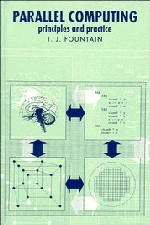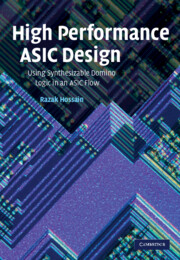Refine search
Actions for selected content:
404 results in Computer engineering
Part 1 - Preliminaries
-
- Book:
- Switching and Finite Automata Theory
- Published online:
- 05 June 2012
- Print publication:
- 22 October 2009, pp 1-2
-
- Chapter
- Export citation
4 - Minimization of switching functions
- from Part 2 - Combinational logic
-
- Book:
- Switching and Finite Automata Theory
- Published online:
- 05 June 2012
- Print publication:
- 22 October 2009, pp 67-107
-
- Chapter
- Export citation
11 - Asynchronous sequential circuits
- from Part 3 - Finite-state machines
-
- Book:
- Switching and Finite Automata Theory
- Published online:
- 05 June 2012
- Print publication:
- 22 October 2009, pp 338-371
-
- Chapter
- Export citation
Part 2 - Combinational logic
-
- Book:
- Switching and Finite Automata Theory
- Published online:
- 05 June 2012
- Print publication:
- 22 October 2009, pp 35-36
-
- Chapter
- Export citation

Parallel Computing
- Principles and Practice
-
- Published online:
- 29 September 2009
- Print publication:
- 03 November 1994

High Performance ASIC Design
- Using Synthesizable Domino Logic in an ASIC Flow
-
- Published online:
- 14 September 2009
- Print publication:
- 21 August 2008
Contents
-
- Book:
- Practical Design Verification
- Published online:
- 05 August 2012
- Print publication:
- 11 June 2009, pp v-ix
-
- Chapter
- Export citation
7 - Decision diagrams for verification
-
-
- Book:
- Practical Design Verification
- Published online:
- 05 August 2012
- Print publication:
- 11 June 2009, pp 173-245
-
- Chapter
- Export citation
List of contributors
-
- Book:
- Practical Design Verification
- Published online:
- 05 August 2012
- Print publication:
- 11 June 2009, pp x-xii
-
- Chapter
- Export citation
Index
-
- Book:
- Practical Design Verification
- Published online:
- 05 August 2012
- Print publication:
- 11 June 2009, pp 269-276
-
- Chapter
- Export citation
6 - SystemVerilog and Vera in a verification flow
-
-
- Book:
- Practical Design Verification
- Published online:
- 05 August 2012
- Print publication:
- 11 June 2009, pp 154-172
-
- Chapter
- Export citation
5 - Test generation and coverage metrics
-
-
- Book:
- Practical Design Verification
- Published online:
- 05 August 2012
- Print publication:
- 11 June 2009, pp 122-153
-
- Chapter
- Export citation
2 - Transaction-level system modeling
-
-
- Book:
- Practical Design Verification
- Published online:
- 05 August 2012
- Print publication:
- 11 June 2009, pp 51-91
-
- Chapter
- Export citation
8 - Boolean satisfiability and EDA applications
-
-
- Book:
- Practical Design Verification
- Published online:
- 05 August 2012
- Print publication:
- 11 June 2009, pp 246-268
-
- Chapter
- Export citation
4 - System debugging strategies
-
-
- Book:
- Practical Design Verification
- Published online:
- 05 August 2012
- Print publication:
- 11 June 2009, pp 113-121
-
- Chapter
- Export citation
1 - Model checking and equivalence checking
-
-
- Book:
- Practical Design Verification
- Published online:
- 05 August 2012
- Print publication:
- 11 June 2009, pp 1-50
-
- Chapter
- Export citation
3 - Response checkers, monitors, and assertions
-
-
- Book:
- Practical Design Verification
- Published online:
- 05 August 2012
- Print publication:
- 11 June 2009, pp 92-112
-
- Chapter
- Export citation
Frontmatter
-
- Book:
- Practical Design Verification
- Published online:
- 05 August 2012
- Print publication:
- 11 June 2009, pp i-iv
-
- Chapter
- Export citation
5 - PLC-Automata
-
- Book:
- Real-Time Systems
- Published online:
- 06 January 2010
- Print publication:
- 11 September 2008, pp 189-240
-
- Chapter
- Export citation
Acknowledgements
-
- Book:
- Real-Time Systems
- Published online:
- 06 January 2010
- Print publication:
- 11 September 2008, pp xii-xiv
-
- Chapter
- Export citation
